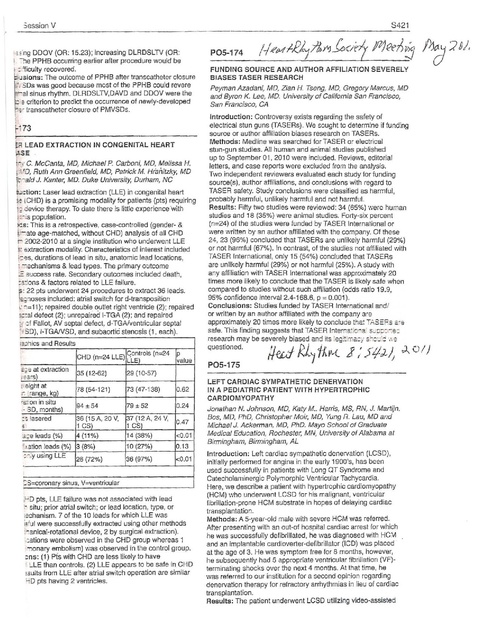Heart Rhythm Society Meeting Tseng Article on Taser Research Bias 2011
Download original document:

Document text

Document text
This text is machine-read, and may contain errors. Check the original document to verify accuracy.
5421 3ession V I-!-€'MI-Rj7;1t,Y1~(/fiJ!l1~dvjy ,,,'ng ODOV (OR: 15.23); increasing OLRDSLTV (OR: I -Ole PPHB occurring earlier aller procedure would be POS-174 'i~ 'ficulty recovered. liusions: The outcome of PPHB after transcatheter closure FUNDING SOURCE AND AUTHOR AFFILIATION SEVERELY BIASES TASER RESEARCH Ii', SDs was good because most of the PPHB could revere Iral sinus rhythm. DLROSLTV,OAVD and ODOV were the :'1 =- criterion to predict the occurrence of newly-developed ':~- transcatheter closure of PMVSOs. Peyman Azadani, MD, Zian H. Tseng, MD, Gregory Marcus, MD and Byron K. Lee, MD. University of Calilornia San Francisco, San Francisco, CA I r~73 ~ LEAD EXTRACTION IN CONGENITAL HEART ~SE .,,. C. McCan/a, MD, Michael P. Carboni, MD. Melissa H. \ ", '0, Ruth Ann Greenfield, MD, Patrick M. Hr'anitzky, MD -r3id J. ~ Kanter, MD. Duke University, Durham, NC 'otion: Laser lead extraction (LLE) in congenital heart :: \CHD) is a promising modality for patients (pts) requiring I; device therapy. To date there is little experience 'with I""s population. 'os: This is a retrospective, case-controlled (gender- & !,'-ate age-matched, without CHD) analysis of all CHD r 2002-2010 at a single institution who undelWent LLE ;: sxtraction modality. Characteristics of interest included I=~s, durations of lead in situ, anatomic lead locations, • ".chanisms & lead types. The primary oufcome ::0 success rate. Secondary outcomes included death, ci.i:ons & factors related to LLE failure. 22 pts undelWent 24 procedures 10 extract 36 leads. gnoses included: atrial switch for d-transposition .:,=11); repaired double outlet right venfricle (2); repaired ;c:al defect (2); unrepaired I-TGA (2); and repaired ~' 01 Fallot, AV septal defect, d-TGAiventricular septal 'SO), I-TGAiVSD, and subaortle stenosis (1 each) I" t30hics and Results CHD (n=24 LLE) C;O~:rOIS (n=24 LLE ~; ~ at extraction ,,,srs) Sl.elght at ,C .,anoe, ko) '"arcn in situ . SO, months) :-:: fasered ~;e leads (%) :;.tation leads (%» : ·,iy using LLE p value 35 (12-62) 29 (10-57) 78 (54-121) 73 (47-138) 0.62 94 ±54 79 ±52 0.24 \36 I~~ A, 20 V, 1 CS 4 (11%) 37 ~~A, 24 V, 1 CS t4 (38%) <0.01 3(8%) 10 (27%) 0.13 26 (72%) 36 (97%) !,,0.01 0.47 :S=coronary sinus, V=ventricular D pfs, LLE failure was not associated with lead \.. situ; prior atrial switch; or lead location, type, or lechanism. 7 of the 10 leads for which LLE was i,'ul were successfully extracted using other methods :"anical-rotational device, 2 by surgical extraction). :ations were observed in the CHD group whereas 1 "'1onary embolism) was observed in the control group. ons: (1) Pis with CHD are less likely to have LLE than controls. (2) LLE appears to be safe in CHD 13ults from LLE after atrial switch operation are similar '-:0 pts having 2 ventricles. I.... Introduction: Controversy exists regarding the safety of electrical stun guns (TASERs). We sought to determine if funding source or author affiliation biases research on TASERs. Methods: Medtine was searched for TASER or electrical stun-gun studies. All human and animal studies published up to September 01, 2010 were included. Reviews, editorial letters, and case reports were excluded from Ihe analysis. Two independent reviewers evaluated each study for funding source(s), author affiliations, and conclusions with regard to TASER safety. Study conclusions were classified as harmfUl, probably harmful, unlikeiy harmful and not harmful. Results: Filly two studies were reviewed: 34 (65%) were human studies and 18 (35%) were animal studies. Forty·six percent (n=24) of the studies were lunded by TASER International or were written by an author affiliated with the company. Of these 24, 23 (96%) concluded that TASERs are unlikely harmful (29%) or not harmful (67%). In contrast, of the studies not affiliated with TASER International, only 15 (54%) concluded that TASERs are unlikely harmful (29%) or not harmful (25%). A study with any affiliation with TASER International was approximately 20 times more likely to conclude that the TASER is likely safe when compared to studies without such affiliation (odds ratio 19.9, 95% confidence interval 2.4-168.6, p = 0.001). Conclusions: Studies funded by TASER International andl or written by an author affiliated with the company are apprOXimately 20 times more likely to conclude that T':'.S"f's :;:'9 safe. This finding suggests that TASER Interna~iooa 5_:::~:;:: research may be severely biased and its leg!t'T:ac;.' S;";::';"': .'.~ questioned. tlfd' I<L, fAI'vt j ; 51/2 ACJ '2 gj, 0 ~ 01) POS-17S LEFT CARDIAC SYMPATHETIC DENERVATION IN A PEDIATRIC PATIENT WITH HYPERTROPHIC CARDIOMYOPATHY Jonathan N. Johnson, MD, Katy M.. Harris, MS. RN, J. Martijn. Bas, MD, PhD, Christopher Molr, MD, Yung R. Lau, MD and Michael J. Ackerman, MD, PhD. Mayo School of Graduate Medical Education, Rochesler, MN, University 01 Alabama at Birmingham, Birmingham, AL Introduction: Lell cardiac sympathetic denervation (LCSD), initially performed for angina in the early 1900's, has been used successfully in patients with Long QT Syndrome and Catecholaminergic Poiymorphic Ventricular Tachycardia. Here, we describe a patient with hypertrophic cardiomyopathy (HCM) who undelWenl LCSD for his malignant, ventricular fibrillation-prone HCM substrate in hopes of delaying cardiac transplantation. Methods: A 5-year-old male with severe HCM was referred. After presenting with an out-of hospital cardiac arrest for which he was successfully defibrillated, he was diagnosed with HCM and an implantable cardioverter-deflbrillator (ICO) was placed at the age of 3. He was symptom free for 8 months, however, he subsequently had 5 appropriate ventricular fibrillation (VF)terminating shocks over the next 4 months. At that time, he was referred to our institution for a second opinion regarding denervation therapy for refractory arrhythmias in lieu oi cardiac transplantation. Results: The patient undelWent LCSO utilizing video-assisted

